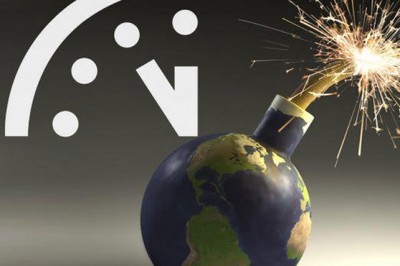The awarding of the 2017 Nobel Peace Prize to the International Campaign to Abolish Nuclear Weapons (ICAN) may mark a turning point in efforts to ensure that humanity survives the nuclear-weapons era. The urgency of ICAN’s work was recently highlighted when the Bulletin of the Atomic Scientists moved its Doomsday Clock forward to just 2 minutes to midnight, the highest level of danger since 1953 and 5 minutes closer to midnight than when concerns about U.S. and Soviet preparations for nuclear war sparked the founding of International Physicians for the Prevention of Nuclear War (IPPNW) in 1980 (see figure).
ICAN was launched in April 2007 by IPPNW. Exactly 50 years earlier, Albert Schweitzer had appealed for a ban on atmospheric nuclear test explosions, whose radioactive fallout endangered human health worldwide. The 1963 Limited Nuclear Test Ban Treaty achieved that goal. Subsequent research has documented the medical consequences of nuclear war and the ineffectiveness of post-attack medical services, making clear the imperative for primary prevention.1,2 IPPNW was awarded the 1985 Nobel Peace Prize. President Mikhail Gorbachev cited IPPNW as a major influence, and President Ronald Reagan agreed that “a nuclear war cannot be won and must never be fought.” When the Cold War ended in 1991, the Clock was set back to 17 minutes to midnight.
Doomsday Clock History, 1947 to 2018: Number of Minutes to Midnight and Selected Events.
But nuclear disarmament has stalled: today, nine countries — Russia, the United States, France, China, the United Kingdom, Pakistan, India, Israel, and North Korea — maintain nearly 15,000 nuclear weapons. Almost 20 years after warnings were published in the Journal and elsewhere about the dangers of “accidental nuclear war,” nearly 2000 weapons remain on “launch-on-warning” hair-trigger alert, despite the growing vulnerability of weapons systems to cyberattack.3
Although President Barack Obama publicly committed the United States in 2009 to the abolition of nuclear weapons, when he left office the country had a $1.25 trillion, 30-year budget to modernize its nuclear arsenal. President Donald Trump has pledged major increases in U.S. nuclear weapons and has threatened to “totally destroy” North Korea with “fire and fury like the world has never seen.” Particularly ominous is the Trump administration’s 2018 Nuclear Posture Review articulating U.S. nuclear-weapons policies, which includes unprecedented plans to use nuclear weapons in response to nonnuclear threats or attacks and plans for the development of “more usable” nuclear weapons.4 The 74-page document makes no mention of Article VI of the Treaty on the Non-Proliferation of Nuclear Weapons (NPT), which commits all signatories “to pursue…nuclear disarmament,” or of the specific commitments to disarmament made by the United States and other nuclear-armed states in the 2010 NPT action plan. President Vladimir Putin recently boasted about Russia’s new and “invincible” nuclear weapons, including nuclear-powered cruise missiles and intercontinental autonomous torpedoes. Despite decades of advocacy by physicians and others, a nuclear strike remains only a computer malfunction, other human or technical error, or military escalation away.
How, then, could we be at a turning point?
ICAN applies to nuclear weapons a proven strategy for making progress toward the elimination of other inhumane and indiscriminate weapons, such as biologic and chemical weapons, antipersonnel land mines, and cluster munitions. This approach can be summarized as stigmatize, prohibit, and eliminate. In each case, weapons that cannot be used without unacceptable consequences have first been prohibited in an international treaty, which has laid the foundation for their progressive elimination. ICAN has rapidly grown into a global campaign coalition of nearly 500 partner organizations in more than 100 countries with the goal of uniting all sectors of civil society, in partnership with governments, to work toward complete nuclear disarmament.
Whereas studies on the health effects of nuclear war have traditionally focused on the direct effects of nuclear explosions on populations in targeted countries, more recent studies have confirmed that most deaths would probably occur in noncombatant states. Even a “limited” nuclear war involving 100 Hiroshima-size nuclear weapons (less than 1% of the current stockpile of weapons, and within the capacity of any of the nine nuclear-armed states, with the probable exception of North Korea) would ignite massive confluent fires that would release millions of tons of smoke and soot into the atmosphere. Such pollutants would cause substantial global cooling, drying, and darkening for more than a decade, disrupting food production worldwide and putting more than 2 billion people, the majority of them in Africa and Asia, at risk for death from starvation.1
Recent false alarms of impending nuclear attacks in Hawaii, Japan, and Guam, and disclosures that the U.S. National Security Agency’s computers have been successfully hacked, have demonstrated that the risk of a nuclear war started by mistake or because of a cyberattack is growing.5 For decades, nuclear-armed states claimed a right to possess nuclear weapons for their own national security. Apart from the ethical issues inherent in basing perceived security on the capacity to indiscriminately wipe out millions of civilians, the theory that “mutually assured destruction” will ensure that countries never actually use nuclear weapons has assumed — contrary to all evidence — the infallibility of both technical systems and human judgment during times of crisis. In reality, the fallibility of human and technical systems and the global devastation that would result from a nuclear attack means that any country possessing nuclear weapons is accepting an ever-increasing possibility of self-destruction.
Past efforts to promote disarmament were often mired in the arcane policy labyrinths of nuclear-armed states. ICAN maintains that given the catastrophic humanitarian consequences of any use of nuclear weapons and the impossibility of guaranteeing that such weapons will never be used, ensuring the survival of human civilization requires the complete elimination of nuclear weapons. Compelling medical, scientific, and moral arguments against nuclear weapons have proven insufficient. ICAN’s work therefore focuses on translating these arguments into binding legal prohibitions.
Although legal arguments for disarmament have stressed that the use of nuclear weapons would violate international humanitarian law (i.e., it would constitute a war crime), the legal status of possession of such weapons is less clear. Much of current international law — from the outlawing of slavery to the banning of chemical and biologic weapons — grew out of moral stigmatization of a previously accepted practice. A crucial milestone was obtaining the active support of the International Red Cross and Red Crescent Movement, the world’s largest humanitarian network, for the prohibition and elimination of nuclear weapons.
ICAN’s first major victory was the adoption of the Treaty on the Prohibition of Nuclear Weapons at the United Nations in July 2017. The treaty was supported by 122 countries, although all nuclear-armed countries and many of their allies boycotted the negotiations. Political strategies for turning moral and legal stigmatization of nuclear weapons into verifiable elimination will vary from country to country. ICAN’s “Don’t Bank on the Bomb” campaign encourages individual investors, banks, pension funds, and other entities to divest from any company involved in nuclear-weapons production. The largest pension funds in Norway and the Netherlands have already agreed to do so. The World Bank’s recent decision to divest from fossil fuels raises the possibility of similar action by major investors regarding nuclear weapons.
The road to abolition will take years, and immediate steps to reduce the likelihood that nuclear weapons will be used are urgently needed. In the United States, the “Back from the Brink” grassroots campaign has begun seeking endorsements from cities and towns, medical and other professional organizations, faith communities, health facilities, and other groups.
BACK FROM THE BRINK: THE CALL TO PREVENT NUCLEAR WAR*
We call on the United States to lead a global effort to prevent nuclear war by
- 1. Renouncing the option of using nuclear weapons first
- 2. Ending the sole, unchecked authority of any president to launch a nuclear attack
- 3. Taking U.S. nuclear weapons off hair-trigger alert
- 4. Cancelling the plan to replace its entire arsenal with enhanced weapons
- 5. Actively pursuing a verifiable agreement among nuclear-armed states to eliminate their nuclear arsenals
ICAN’s Nobel Peace Prize is a step toward mobilizing citizens worldwide to help ensure that humanity survives the existential threat posed by nuclear weapons. The Treaty on the Prohibition of Nuclear Weapons lights a path that all countries can take. The stakes could not be higher.
*
From the Ethics Programs and the Division of General Medicine and Primary Care, Beth Israel Deaconess Medical Center, and Harvard Medical School — both in Boston (L.F.); the Nossal Institute for Global Health, University of Melbourne, Carlton, VIC, Australia (T.R.); and the International Campaign to Abolish Nuclear Weapons, Geneva (S.T.). Dr. Ruff is founding chair of ICAN, and Ms. Thurlow was a corecipient of the Nobel Peace Prize on ICAN’s behalf; Dr. Forrow is the former chief executive officer, and Dr. Ruff the copresident, of IPPNW.
Notes
1. Helfand I, Haines A, Ruff T, Kristensen H, Lewis P, Mian Z. The growing threat of nuclear war and the role of the health community. World Med J 2016;62:86–94.
2. Forrow L, Sidel VW. Medicine and nuclear war: from Hiroshima to mutual assured destruction to abolition 2000. JAMA 1998;280:456–461. Crossref Medline
3. Forrow L, Blair BG, Helfand I, et al. Accidental nuclear war — a post-Cold War assessment. N Engl J Med 1998;338:1326–1331. Free Full Text Web of Science Medline
4. Sanger DE, Broad WJ. To counter Russia, U.S. signals nuclear arms are back in a big way. New York Times. February 4, 2018 (https://www.nytimes.com/2018/02/04/us/politics/trump-nuclear-russia.html).
5. Shane S, Perlroth N, Sanger DE. Security breach and spilled secrets have shaken the N.S.A. to its core. New York Times. November 12, 2017 (https://www.nytimes.com/2017/11/12/us/nsa-shadow-brokers.html).
The original source of this article is NEJM






/https://www.niagarafallsreview.ca/content/dam/thestar/news/canada/2021/09/25/huawei-executive-meng-wanzhou-receives-warm-welcome-upon-return-to-china/_1_meng_wanzhou_2.jpg)













No comments:
Post a Comment
Note: Only a member of this blog may post a comment.